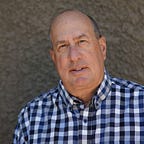ust sing “My Way”!!!
When I was growing up, Frank Sinatra was at the peak of his career. The Michael Bublé of the sixties classic crooner would stride on stage, snapping his fingers to Nelson Riddle’s band, often introduced as “The Chairman of the Board”. Funny though: apparently, Sinatra didn’t like being called “The Chairman”. The moniker allegedly stuck because he was the Founder of Reprise Records and with that came chairmanship of the company Board.
Today, we have people trained to be Directors — many countries have one or more director training and certification programs, often attached or affiliated with universities, teaching people the rules of the road of governance.
Director training is replete with structure and process. There’s even exams! How do we evaluate the CEO? What are the roles and responsibilities of major committees? The training is somewhat like memorizing the wiring diagram for the electrical system of an airplane — necessary to prove you are qualified, but at the end of the day I want a pilot at the front of the plane who knows how to fly. Not only how to fly, but how to fly under different weather conditions. Someone experienced and can “feel” the turbulence as it buffets the aircraft.
Chairs pilot boards. That is a central issue and challenge in today’s governance regardless of what country you look at. We may be raising the bar on governance by improving through director education — and adopting approaches that broaden diversity and consider relevant skills and skill gaps of the group. To me, that’s like enhanced wiring. As a world made up of organizations, we have done very little to think through “pilot training”.
Real pilots use simulators to practice, before gunning the throttle on the runway. Professional golfers, surgeons, and accountants go through some form of apprenticeship a part of the road to full professionalism. The stats show that most people who chair a board have done zippo-nada-nothing to prepare for the role. For lots of people, chairing is like being a traffic cop — you steer the group through an agenda prepared by “someone”. Make sure the decisions that need to be made actually get made.
The lack of “professionalism” within the cohort of chairs stems, in part, from the fact chairs have very little direct power over the people and circumstances they deal with. A person who aspires to chair may have little (or zero) influence over “who” votes, and how. That process is often (at least) a bit opaque. Consider how the Roman Catholic church selects its leader. In that case, the opaque decision-making process literally involves the use of smoke. Corporations may have a governance committee that deliberates confidentially. There, the smoke takes the form of a short motion appointing certain people to certain positions. The conversation that lies beneath remains in the embers of private conversation and committee exchanges.
Chairs may also experience some boundaries and rules that dictate who can become board peers. Representative boards, staggered terms, and multiple voting rights may contort the process of director selection. The people making those decisions are elected or appointed by shareholders, which introduces another degree of separation between stakeholders and chair. From the subset of directors, the board selects its chair — on criteria that vary widely but often lean towards some form of length of service or “seniority”. So, chairing is (often) not a meritocracy.
So now, let’s say like Sinatra, you are Chair (and maybe didn’t want to be). What can you do to manage the board? Sinatra had a reputation for aggressively striking back at people who rubbed him the wrong way. He did it “his way”. Sinatra’s chairmanship style would not cut it in today’s boardroom. Telling people to “sing My Way” (or else!) would be a tone-deaf approach to enhancing the quality of boardroom dialogue.
Because board chairs are not Sinatra like bosses calling the tune. Chairs almost never have unilateral “boss” autonomy and authority to hire and/or fire the chief executive. That power rests with the full board, not one board member. Board chairs do not typically have a (traditional sense) boss — a real person with a real face who interviewed them and ultimately made the hiring decision, saying, “Welcome to our company…I hope you like the opportunity and agree to join our team as . . . board chair!”
Nor does the chair have a boss. Someone to go to for guidance. The chair — like Frank Sinatra — is Aladdin’s genie; perceived to be powerful. But in fact, the chair lives in Aladdin’s lamp, with hand cuffs on their freedom to operate. So, bottom line, in the absence of direct power, chairs ultimately have but one arrow in their quiver. It is personal influence. And the exercise of influence, like piloting a plane through turbulence, requires skill beyond the wiring diagrams.
How can we incubate leaders, to be great chairs? This has been my journey into writing a book. Two years and 271 pages later, as Michelangelo said at age 87, “I’m still learning”. And writing more on the issue.
However great the conceptual knowledge and understanding might be, in the face of real experience, concepts are like flakes of snow fallen on a burning fire. — Zenkai Shibayama
https://twitter.com/thegreatchair1
